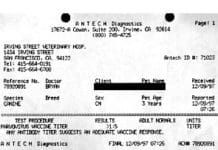Heartworm Medicine Side Effects: Reader Experiences
Whole Dog Journal readers respond to the WDJ article "Reflections on Heartworm" with their stories of heartworm medicine side effects.
Purchasing Veterinary Prescription Drugs for Your Dog
Traditionally dispensed solely from the veterinarian’s office, prescription drugs for companion dogs represent a ripe peach – ready for picking by retail chain pharmacies and emerging Internet-based pharmacies that have sniffed out a promising new niche in the lucrative pharmaceutical market. These drug retailers have discovered the more than 35 million dog owners in the United States who anticipate the same access to sophisticated medicines for their dogs as they have come to expect for themselves.
Indoor and Patio Litterboxes for Home-Alone Dogs
To most people, the word “house-trained” refers to a dog who has been trained not to urinate or defecate indoors. For my parent’s generation, this bit of training was usually accomplished by Mom, who stayed home while the rest of the family went to work or to school. As double-income families became the norm, the home-alone dog was faced with a serious problem. By the time you add a lunch hour and commute time onto an eight-hour work day, a house dog may have to “hold it” for as long as 10 hours before someone finally comes home to let her out. Her legs are probably tightly crossed for at least the last two.
Heartworm Treatment Options
The heartworm (Dirofilaria immitis) is a nematode or roundworm named for its place of residence, inside the heart. To understand the challenge of controlling this parasite, you have to understand its life cycle, a complex and slightly bizarre process. Living in a dogs pulmonary arteries, adult heartworms mate. Each female (which can reach sizes of up to 11 inches) produces thousands of eggs, each less than 1/800th of an inch, which are called microfilariae, and circulate in the blood.
CoQ10 for Heart Health in Dogs
Who hasn't heard of CoQ10? A powerful antioxidant, coenzyme Q10 is one of America's most popular supplements. Literally every cell of the body contains CoQ10. In fact, its other name is ubiquinone, reflecting its widespread distribution in the body. CoQ10 is most concentrated in the mitochondria, the portion of cells that produce energy. The heart and liver contain more mitochondria per cell than other body parts and thus contain the most CoQ10.
Protecting Your Dog from Parvovirus
When parvo strikes, it moves fast. Infected dogs may appear to be in perfect health one day and violently ill the next. Emergency veterinary care is expensive, and unless dogs are diagnosed and treated early, many die from this serious disease. However, reactions to parvovirus vary widely both among dogs and their human caretakers. In a world in which parvovirus is ubiquitous it is literally everywhere except environments that have been sterilized parvo kills some dogs and leaves others unscathed.
Keeping Your Dog Hydrated
Every good hiker knows how important it is to stay hydrated. We also know that water can be hard to come by on those rugged mountaintop trails, and that the only water at some beaches is briny and undrinkable. What’s a responsible canine caretaker to do? A good dog bottle should be sturdy, easy to fill, easy to dispense water from, hold an ample water supply, come with a workable dish from which your dog can drink, be comfortable to carry, not leak (duh!), and be reasonably priced. Insulated sleeves to keep water cool are a bonus, and also provide a nice padded cushion for that bottle that is banging on your hip.
Dealing With Submissive Urination
Submissive urination is a vexing challenge with some puppies and young dogs. Most grow out of it eventually, but in the meantime, how can you help your pup put a cork in it? In the canine world, when one dog wants to show deference to another, more dominant dog, he may urinate as a sign of submission. The more threatened he feels, the more likely he is to urinate. This is an involuntary reaction, an instinctive behavior that all dogs are born “knowing” how and when to exhibit. In a pack of dogs, this programmed behavior is a valuable survival mechanism. Puppies are extremely vulnerable to the wrath of adult dogs in the pack, and built-in submissive responses signal normal adult dogs to automatically shut off the aggression, thus keeping puppies from being hurt.
Finding a Balance Between Conventional and Holistic Dog Care
I’ve heard many stories from people who use holistic practices and get tired of being pressured by their conventional veterinarians to (over) vaccinate, use (sometimes harmful) drug therapy as a first (not last) resort, or feed their dogs a commercial (low-quality) kibble. Sometimes, in an effort to find more sympathetic veterinarians, these caring guardians replaced their conventional primary practitioner with a holistic veterinarian – only to be disappointed by this professional’s resistance to useful conventional medicine!
Regaining What Was Almost Lost
first discovered Petey at their local humane society shelter in 1990. Scheduled for euthanasia the next day
Understanding Congestive Heart Failure in Dogs
Dogs don't experience heart attacks the way humans do, but this doesn't mean they don't die of heart disease. Heart failure is increasingly common in America's dogs, with many showing symptoms by age seven or eight. Even some young dogs develop congestive heart failure, inheriting the propensity for the disease from their parents. Conventional medical practitioners consider congestive heart failure and other circulatory problems to be progressive and irreversible, but holistic veterinarians know that in many cases, heart disease can be slowed, reversed, and even cured. Understanding heart disease will help you prevent it in healthy dogs and treat it in dogs who are already ill.
Older Dogs and the Onset of Cataracts
Cataracts make the lens of the eye opaque or cloudy, which gradually reduces vision to the point of blindness. In their early stages, cataracts cause blurring and distortion of vision, but they are invisible to the naked eye. By the time most owners notice them, cataracts involve more than 60 percent of the dog's eye. Cataracts often accompany other illnesses, such as diabetes and hypothyroidism (low thyroid function). Surgery performed by a veterinary ophthalmologist is the only treatment considered effective in conventional veterinary medicine and is indicated only in cases where the cataracts are not a result of a secondary disease such as diabetes.















